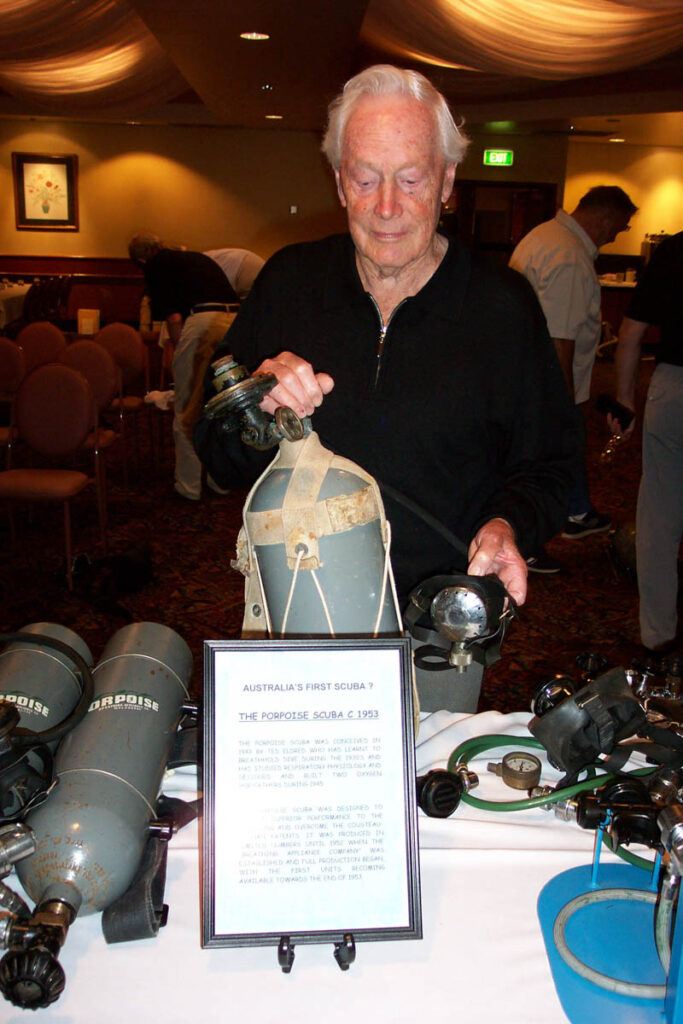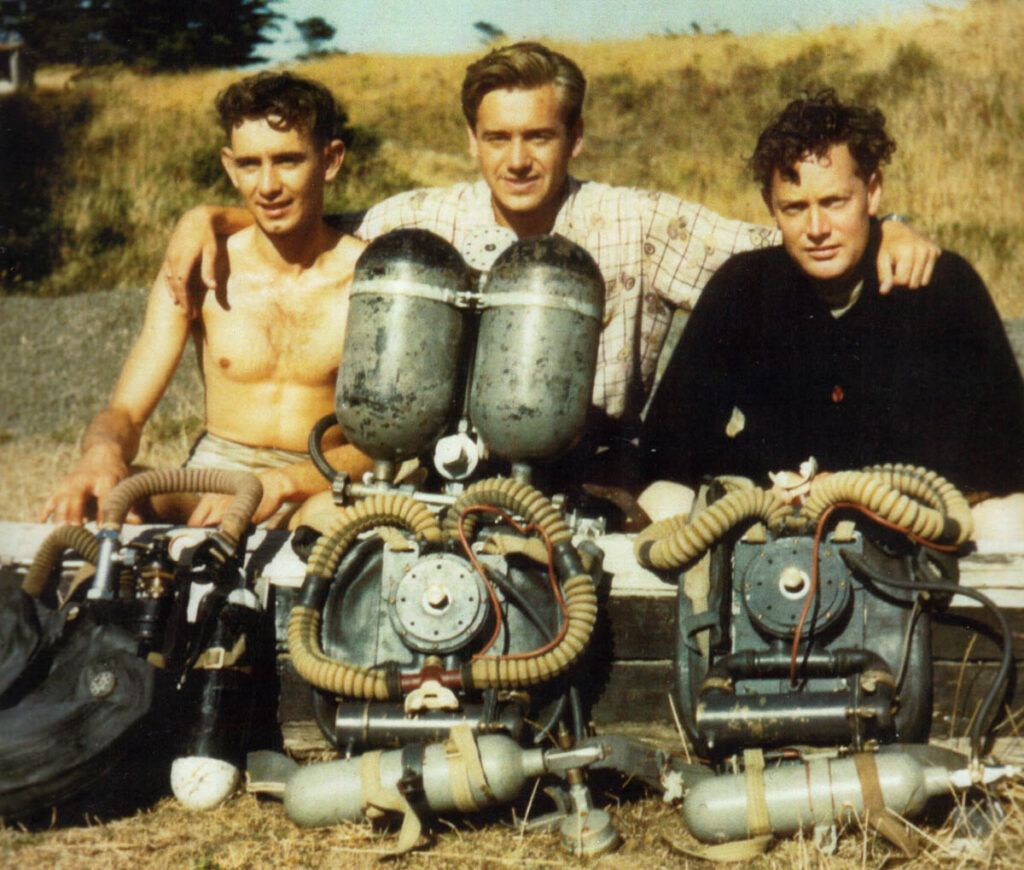Ted Eldred (on the right in above picture) invented Australia’s first scuba oxygen rebreather during the 1950s. It was an oxygen rebreather that would cut off gas if the diver went too deep. Two examples of the rebreather, which was back mounted, can be seen in the lower right. (pic above) Ted worked on air and developed the first single hose air scuba, known as The Porpoise, after a sport diver passed out because he forgot to purge his system.
Ted Eldred was born in Melbourne in 1920. When he was younger, he resided on the Mornington Peninsula, south of Melbourne, close to Sorrento. Before World War II intervened, he began snorkelling as soon as a mask, fins, and snorkel were available. He wished he could create or acquire some kind of free-swimming breathing set. He created an oxygen rebreather for sport diving in the late 1940s, following World War II. Eldred acknowledged that while he was aware of the Cousteau-Gagnan model of the Aqua Lung and its workings, he had never actually used it. The Aqua Lung was difficult to find in Australia and was covered by a patent.
Despite having a license to produce goods for Commonwealth nations, Siebe Gorman (a British company that developed diving equipment) was unable to keep up with demand. Eldred changed his focus to create the first single-hose open-circuit scuba set in history after concluding that rebreathers were unsuitable for recreational use. Both sets were sold under the tradename “Porpoise.”
Eldred’s first goal was to create an oxygen rebreather that was suitable for sports. Under six milliseconds, pure oxygen used in early rebreathers causes CNS poisoning. Eldred reasoned that when the diver went below that depth, the rebreather ought to be made to stop releasing oxygen. A diver fainted during a demonstration near the Flinders pier in Western Port Bay, southeast of Melbourne, as a result of his inability to clear the system of air. There was a build-up of nitrogen as a result of this purging failure. At this point, Eldred realized he had to focus his efforts on breathing apparatuses that used open circuit compressed air. Bob Wallace-Mitchell, who would later become his distributor, accompanied him on this demonstration.

Eldred started working on the Porpoise CA (a prototype), the first single hose regulator in history, after learning that the French-designed open circuit scuba tank, known as the Aqua-Lung, was shielded from patent infringement in the US and other countries. Compared to the Aqua-Lung, his new design was better and did not infringe upon any patents. Since Eldred’s company was too tiny to justify the costs, his regulator was never patented. The CA-1 was the model that was put into production initially. For his prototype, he started using an oxygen welding reduction valve (CA for compressed air, 1 for a single cylinder). His main focus during the design process was creating the demand valve, also known as the second stage. Early in 1952, it was offered for sale as a complete single-cylinder, single-hose scuba. The cylinder was inverted so the diver could reach the innovative regulator mounted reserve. Breathing Appliances Pty Ltd was Eldred’s business, and it was situated in North Melbourne. His friend Bob Wallace-Mitchell handled his marketing. Because compressed air was not widely available in those early days, Wallace-Mitchell found it challenging to market. Finding a compressor with a sales location in each of Australia’s major cities was his first task. Dealers could then stock his scuba and replenish the cylinders after this was finished. Eldred also invented the Porpoise Universal in 1954; it could produce more than 300 litres per minute. The Universal had a modular design and made use of the same demand valve. A balanced diaphragm type reduction valve was altered to resemble a piston type. It turned into his signature model. Eldred also produced the Sportsman, a less expensive model. With its cutting-edge features that are now standard on modern regulators, the Sportsman was an incredibly small regulator. Its first stage was unbalanced and it was constructed of plastic. This model was required by the market, but Eldred did not like it.
Eldred’s efforts were backed by the Royal Australian Navy (RAN), which also adopted the Porpoise Universal for military use. With the acquisition of single hose scuba equipment, the RAN became the pioneer navy. Maurice “Batts” Batterham, GM, the RAN Commander, founded Eldred’s diving school. Located at the Melbourne City Baths, it was the first SCUBA diving school in Australia and the world to teach using a single hose regulator. Originally intended to promote the new Porpoise, other scuba brands were also used in the course. After about ten years of operation, the school closed and its students were transferred to the YMCA to attend the more recent Associated Divers Academy.
Only a few dozen of all the models of the approximately 12,000 Porpoise are known to survive today, and in the hands of scuba collectors. 12,000 of the more popular French Aqua-Lung were made in a single month, a far higher production volume.
Later in life, Ted Eldred was honoured as the creator of the first successful commercially produced single hose SCUBA by the Historical Divers Society (South-East Asia Pacific). At a gathering held in Ted Eldred’s honour, Eldred made his final dive alongside his grandson, Adam. The kind that is currently in use worldwide is the single hose SCUBA. The Historical Diving Society (SEAP) gave Eldred the inaugural “Ted Eldred Award” in recognition of his noteworthy contributions to diving. When Eldred died, he did not have a single complete Porpoise left. Tony, Eldred’s son, received a working porpoise from the Historical Diving Society (SEAP) so that the family could see Ted Eldred’s accomplishments.
At the age of 85, Ted Eldred passed away from cardiac arrest in August 2005 at his country home in Yarck, Victoria, Australia A daughter and a son survive him.







